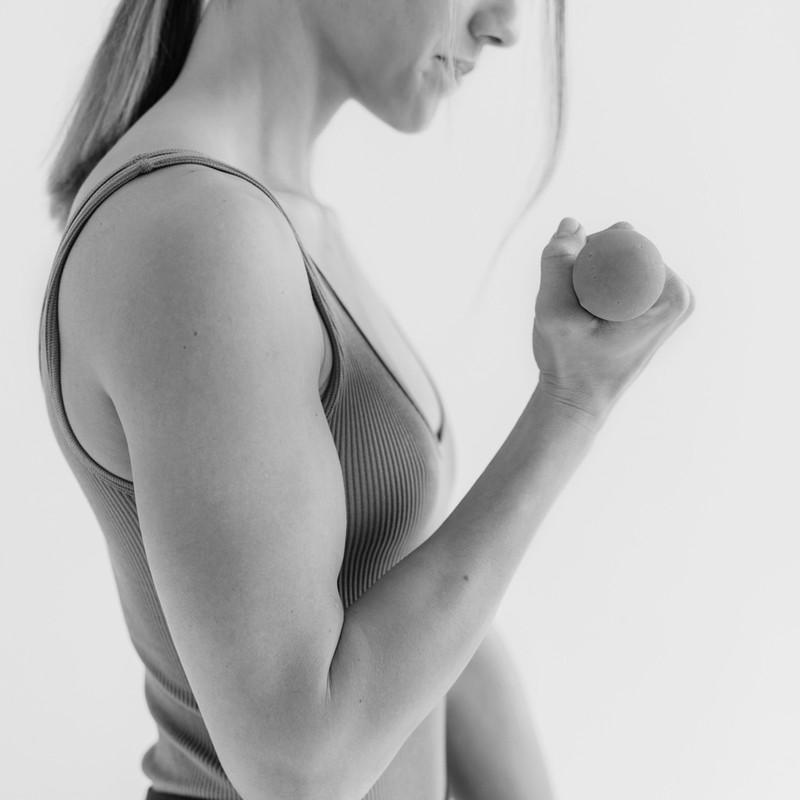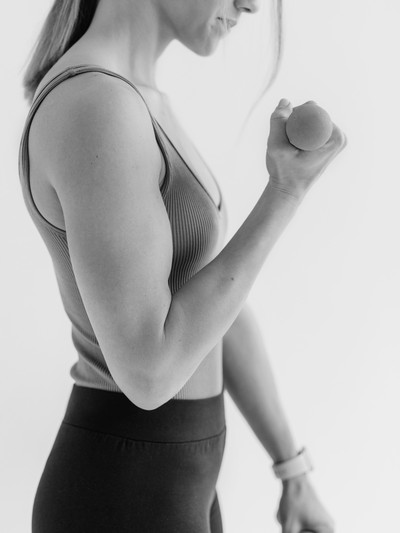

Everything You Need to Know About Toning, Weights & Resistance
What Should You Know About Keeping Fit As You Age?
The first crucial rule about keeping fit as you get older is to use your head as much as your body. “It’s important to know that keeping fit isn’t just about going to the gym once or twice a week. It’s a frame of mind,” advises Gemma Folkard, founder of Shape Pilates. “You should consciously keep yourself active physically and connected mentally within your daily routines. This might mean taking the stairs or walking to the shops rather than getting an online delivery.”
Once you’ve got into the headspace of getting and staying active, look at focusing on exercises that will particularly benefit you and your life stage. “Prioritise activities that improve balance, grip strength and coordination, as these skills tend to decline with age,” adds Pilates expert and personal trainer, Aimee Victoria Long. “Regular exercise can help reduce the risk of falls and maintain overall mobility.” Strength training, yoga and Pilates are all good for this, but anything that keeps your body challenged is great. “Aim for a combination of aerobic exercises, such as walking, running or swimming, and strength training exercises like resistance training or body weight exercises such as push-ups, squats and planks,” says Aimee. Of course, as with anyone who works out, but especially anyone older who’s embarking on a fitness regime for the first time, it’s essential to listen to your body. “Pay attention to any discomfort or pain and consult with a healthcare professional if needed,” adds Aimee.
What’s the difference between toning, weight training and resistance training?
“Toning, weight training, and resistance training are all forms of exercise, but they focus on different aspects of fitness,” explains Aimee. “Toning exercises typically involve lighter weights and higher repetitions, aiming to improve muscle definition and endurance without significant muscle growth.” If you’re looking to build muscle strength and size, then weight training which involves lifting heavier weights repetitively, might be better suited to you. According to Gemma, it typically involves using various forms of free weights like dumbbells, barbells, and kettlebells and “depending on what and how you lift, you can work on balance and stability in different plains, really firing up the brain to body connection and training smaller muscles throughout the body as a whole,” she says. “Resistance training encompasses a broader category that includes both toning and weight training,” says Aimee. “It involves any exercise that utilises resistance, such as resistance bands or bodyweight exercises, to challenge the muscles and improve strength.”
Why Do Certain Types Of Exercise Become More Important As You Get Older?
As we age, we naturally experience a decline in muscle mass and bone density, so it’s important to take that into consideration and ensure you’re doing exercises that counteract this. “Stability, strength and mobility work are essential,” says Gemma. “As muscle mass deteriorates, it’s important to keep topping up with training to stay bodily aware and strong in order to be able to carry out daily tasks with ease as well as avoid injuries. Adding in weights might keep things interesting and provide muscle gain quicker, as long as it’s done properly and safely.”
How Often Should You Do This Type Of Training?
Given how personal exercise is – in other words, what’s right for one person may not be right for another – it’s important to listen to your body and work out what’s right for you. “The frequency of weight, toning or resistance training as you age depends on various factors, including your fitness level and overall health,” advises Aimee. “Generally, it’s recommended to engage in strength training activities at least two days a week, focusing on all major muscle groups and a full body workout. It's important to allow for proper rest and recovery between sessions to avoid overexertion or injury. As we get older, it can take longer to recover between sessions.”
If you’ve been keeping fit for a while, advice from the experts is to stay consistent. “An ideal week would include walking daily, 5-10k steps, two strength training sessions with weights and resistance, and two sessions of mat-based movement like Pilates or yoga,” says Gemma. “By doing this, you’re covering all bases to have overall strength, balance and ease of movement. It should also mean less aches and pains, and a positive frame of mind.”
If You’ve Never Exercised Before, What’s A Good Way To Start?
If you’re relatively new to working out, it’s more effective – and safer – to start slowly and build up in gentle increments. “Starting slowly and gradually increasing intensity is key,” agrees Aimee. “Begin with low-impact activities like walking, swimming or cycling. These activities are gentle on the joints and cardiovascular system. As you build stamina and confidence, you can incorporate strength training exercises using bodyweight or light weights.” Working out with a friend is a great idea if you don’t know where to start, but keep an open mind and don’t fret if you don’t enjoy what they do. “Don’t feel pressured to stick with it,” says Gemma. “Research other forms of movement that float your boat. Nothing is out of bounds, whether you prefer to work towards a skill, like a headstand, a team sport or something more spiritual like Tai Chi – there is so much out there to explore.”
If all else fails and you feel really stuck about what to try, Gemma suggests a spot of reflection. “Look back to your childhood and what you enjoyed or had a passion for and take some inspiration from that.” Whatever you end up choosing, consistency is everything, so make sure it’s something that you’ll be able to fit into your lifestyle and daily routine without having to make any compromises. “Exploring different ways to move is important to find a practice that suits you and can therefore become a consistent part of your routine,” advises Gemma. “It needs to practically work with logistics and location, and you need to connect to the teacher or physical practice to a level where you actually want to go back.”
If You’re Intimidated By Gyms, How Feasible Is It Do This Type Of Exercise At Home?
Thankfully, if gyms are not for you, it couldn’t be easier to tone up or lift weights without having to set foot in one. “We are now in the age of on-demand online workouts, so every form of training is accessible and it’s easy to get started from the comfort of your own home,” says Gemma. “Find a certified instructor that you relate to and try before you buy. Many online workouts have trial periods, so take advantage of that before committing.” You don’t need much, if any, equipment to start a good fitness regime so, if you’re determined to keep fit without a gym, then that needn’t be a hindrance.
“Bodyweight exercises, such as squats, lunges, push-ups and planks, require minimal equipment and can be done in the comfort of your own home,” says Aimee. “Additionally, resistance bands are portable and versatile tools for strength training.” If you want to start building tone and strength slowly, you don’t even need to properly commit to a formal idea of exercise. “Doing everyday physical tasks is just as important,” says Gemma.” “As we age, we have more inclination to seek ease and comfort. If a partner offers to carry your bags, politely decline – these are the key, consistent movement snacks that build strength, agility and confidence.”
What Sort Of Weight Or Resistance Is Good To Start With?
“The appropriate weight or resistance amount for weight training or resistance exercises varies depending on individual strength and fitness level,” says Aimee. “I’d recommend starting with lighter weights or resistance bands and gradually increase the load as you become stronger and more comfortable. This is called progressive overload.” As a rule, for weight training, she recommends choosing a weight that allows you to perform 8-12 repetitions with proper form before experiencing muscle fatigue. “When using resistance bands, select a band with an appropriate level of tension that challenges your muscles without causing pain or compromising on technique. Experimenting with different weights or bands will help you find the suitable level of resistance for your workouts,” she adds.
Visit Shape-Pilates.com & follow @AimeeVictoriaLong
DISCLAIMER: We endeavour to always credit the correct original source of every image we use. If you think a credit may be incorrect, please contact us at info@sheerluxe.com.





